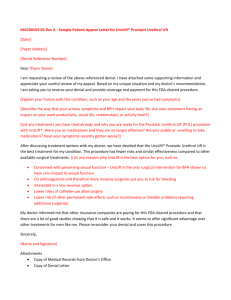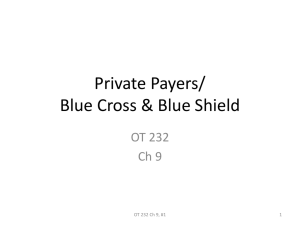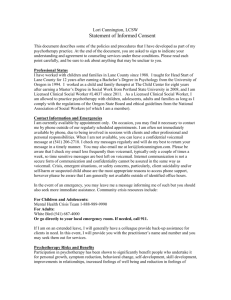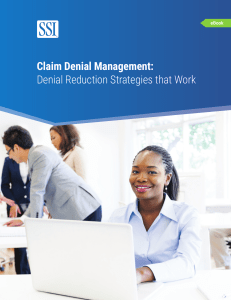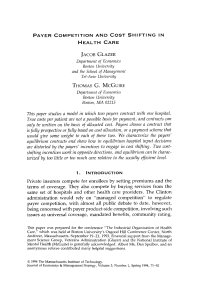Claim LifeCycle Manager
advertisement
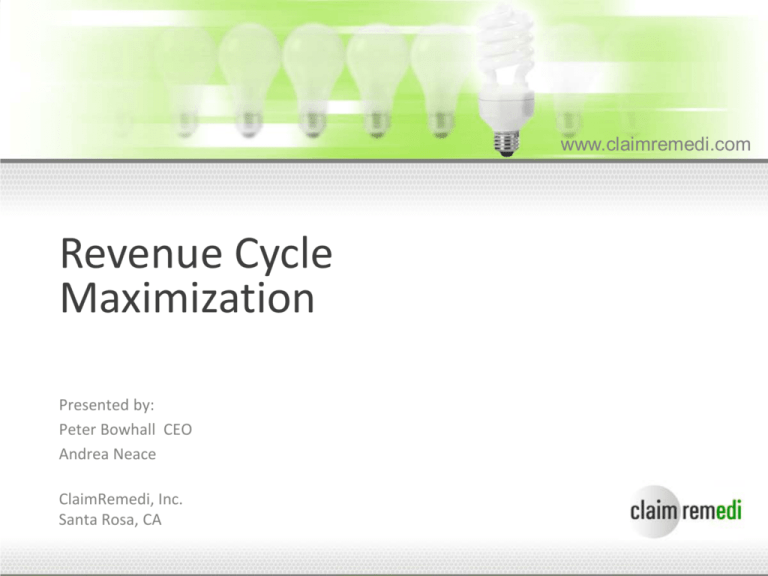
www.claimremedi.com Revenue Cycle Maximization Revenue Cycle Maximization Presented by: Peter Bowhall CEO Andrea Neace ClaimRemedi, Inc. Santa Rosa, CA FQHC Revenue Cycle At its core is the Claim Revenue Cycle • Maximizing claim revenue • Accelerating claim revenue • Managing the process Claim Revenue Cycle The complete Claim Revenue Cycle process involves: • Staff– clinical, front desk, billing office • EMR/PM systems • Clearinghouse/EDI Services Survey- Question Survey Question: Do you know what percentage of your claims are denied? Survey- Response Do you know what % of your claims are denied? Survey said: • 24% = 1%-10% denial rate • 28% = 11%-30% denial rate • 6% = 30%-50% denial rate • 42% = don’t know Rejection/Denial Statistics • 20%-30% of claims are rejected or denied on first submission • 33% of denials are not recovered (The Physician Billing Process) • Initial claim cost = $5-$7 versus $25-$30 to rework a rejected/denied claim Payment Statistics • Payers report the incorrect contracted payment rate on 12%-21% of claims • 20% of claims are underpaid • Underpayment equates to 7% of net revenue What’s Ahead • 5010 (January 2012) • ICD10 (October 2013) • Physician Quality Reporting Initiative—PQRI (2015) Claim Lifecycle Management • Eligibility • Claim Submission • Claim Scrubbing & On-line Editing • Claim Tracking Management by Exception • ERA Processing • Analytics—Denial Management, Benchmarking, Dashboards Eligibility Verification • One of two ways to reduce first pass rejections • Eligibility is one of the most common causes for claim rejections • Study—8% of total claims submitted rejected due to eligibility issues Eligibility Verification • Is the patient covered? • Does the patient have other insurance? • Do we have the correct registration info? • What are the maximum allowable visits? • What is the patient’s share of cost? The first step in the claim revenue life cycle. Eligibility Statistics 79% of practices check patient eligibility. 24% check patient eligibility every visit (MGMA-Larson Allen LLP). Best performers check eligibility: • For all patients • Every patient visit • Using EDI technology Best Performers Lower A/R days and shorter collection cycle. Other things they have in common: • They do more analysis than others • They have more support staff per provider • They utilize more technology services Claims Scrubbing • The second way to reduce first pass rejections • Identify & correct errors before claims are sent to payers • “Reverse engineer” ERAs to identify payer specific edits Scrubber Rules Engine Why “reverse engineer” ERAs to identify payer specific edits? • Edits vary significantly by payer • Many payers do not use industry wide standards • Many payers use undisclosed proprietary edits • “We do not release what we do and do not edit.” Claim Management Track and monitor the status of all claims after they have been forwarded to payers. Manage by exception those claims that are: • Rejected, pended or denied—claims requiring rework or follow-up • Missing in action—payer “lost” or never received claim Claim Management Claim Management Claim Management Proof of timely filing: • Claims that never make it into adjudication • Payers want to see the acknowledgment they sent you– not your record of when you sent claims Revenue Cycle Management You can’t manage what you don’t measure. Claim Revenue Cycle Management consists of: • Managing denials • Comparing payer reimbursements with contracted amounts Analytics • If you are getting 835s (ERAs) & 277s, you have all the data you need. • “Data is not information. You have to torture it before it becomes useful.” (MGMA conference) • Analytics tools are often underused. • Enables you to manage the claim process instead of letting the claim process manage you. Denial Management Managing denials with technology instead of manual processes can significantly lower your A/R days – no matter how good your manual processes are. • Identify reasons for denials • Implement staff training at the source • Reduce denials • Fix process instead of fixing individual claims • Measure effectiveness of denial management Denial Management Denial Management Denial Management Track denials by payer, procedure, provider, location and user. • Identify who or what is causing denials– front desk, back office, etc. • Identify problem payers & their requirements • Drill down to claim detail Payment Monitoring Track actual allowed amounts by procedure, modifier & payer: • Ensure payments are in line with your contracts • Identify underpayments Those who monitor allowed amounts will find incorrect payments from payers. Payment Monitoring Underpayments How do payers underpay: • Payer errors • Partially paid claims • Downcoding Payment Monitoring Payer Comparisons Compare payers by: • Reimbursement—allowed amounts by procedure & modifier • Denials • Days to pay Days to Pay Days to Pay Payment Monitoring How Do You Compare How do you compare with other provider organizations? How do you stack up? • By specialty, zip code, state & payer • Allowed amounts by procedure, modifier & payer • Denials • What percentile do you fall into? How Do You Compare Questions? Questions?

